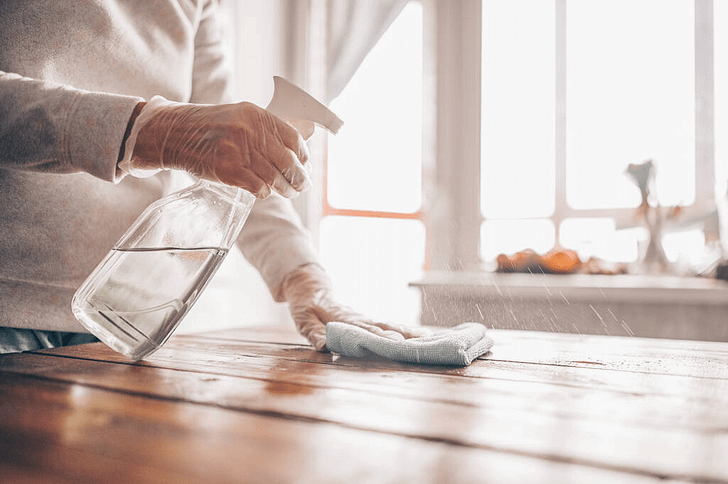Living with allergies can be a constant struggle, especially when it comes to keeping your home clean and allergen-free.
Dust, pet dander, and pollen can trigger allergic reactions, making it essential to maintain a clean living space.
In this blog post, we will provide you with the ultimate cleaning tips for allergy sufferers, helping you create a healthier environment and breathe easy.
Understanding Allergens
Before diving into cleaning tips, it's crucial to understand the common allergens that can trigger allergies.
Allergens are substances that cause an allergic reaction in sensitive individuals.

The most common household allergens include:
- Dust mites: These microscopic creatures reside in bedding, carpets, upholstery, and soft furnishings.
- Pet dander: Shed skin cells, fur, or feathers from animals can trigger allergies.
- Pollen: Outdoor allergens brought indoors can cause discomfort.
- Mold spores: Mold thrives in damp areas such as bathrooms, basements, and kitchens.
- Cockroaches: Their saliva, feces, and body parts can trigger allergic reactions.
Now that we have identified the primary culprits, let's move on to the cleaning tips.
Cleaning Tips for Allergy Sufferers
1. Establish a Cleaning Routine
Consistency is key when it comes to maintaining a clean and allergen-free living space.
Establishing a cleaning routine will help you stay on top of allergen control.
Here are some tips to create an effective cleaning routine:

1. Set a Schedule
Create a weekly or bi-weekly cleaning schedule that includes specific tasks for each day.
This way, you can tackle one area at a time without feeling overwhelmed.

2. Start from the Top
When cleaning a room, it's best to start from the top and work your way down.
This way, any dust or allergens that fall will be removed during subsequent cleaning tasks.

3. Use Allergen-Proof Bedding
Invest in hypoallergenic mattress and pillow covers to protect yourself from dust mites.
These covers act as a barrier between allergens and your bedding.
2. Dusting and Vacuuming Techniques
Dusting and vacuuming are essential for removing allergens that accumulate on surfaces and in carpets.
However, it's essential to use the right techniques to ensure effectiveness.

1. Use Microfiber Cloths
Avoid using feather dusters or dry rags when dusting, as they tend to spread allergens around.
Instead, use microfiber cloths that trap dust particles effectively.

2. Vacuum with HEPA Filters
Invest in a vacuum cleaner with a HEPA (High-Efficiency Particulate Air) filter.
These filters can capture small particles like pet dander, dust mites, and pollen.

3. Pay Attention to Hard-to-Reach Areas
Don't forget to dust and vacuum hard-to-reach areas like ceiling corners, window sills, and behind furniture.
These areas often accumulate allergens over time.
3. Cleaning Upholstery and Soft Furnishings
Upholstered furniture and soft furnishings can harbor allergens such as pet dander and dust mites.
Follow these tips to keep them clean:

1. Wash Removable Covers
If possible, opt for furniture with removable covers that can be washed regularly.
Use hot water to kill dust mites effectively.

2. Vacuum Upholstery
Regularly vacuum your upholstery using a brush attachment to remove any trapped allergens.
Pay special attention to areas where pets spend time.

3. Steam Clean Carpets and Rugs
Steam cleaning carpets and rugs helps eliminate allergens embedded in the fibers.
Make sure to use a steam cleaner with a HEPA filter for optimal results.
4. Kitchen and Bathroom Cleaning
The kitchen and bathroom are areas prone to moisture and mold growth.
Follow these tips to maintain a clean and allergy-friendly environment:

1. Keep Surfaces Dry
Wipe down kitchen and bathroom surfaces to prevent mold growth.
It's essential to keep these areas dry to avoid triggering allergies.

2. Clean Appliances Regularly
Clean appliances like refrigerators, ovens, and microwaves regularly to prevent food buildup and mold growth.

3. Use Natural Cleaning Products
Opt for natural cleaning products or homemade solutions to avoid harsh chemicals that may trigger allergies.
Vinegar, baking soda, and lemon juice are effective alternatives.
5. Pet Care Tips
If you have pets at home, it's crucial to take extra measures to minimize allergens they may produce.
Here are some pet care tips for allergy sufferers:

1. Create Pet-Free Zones
Designate certain areas of your home as pet-free zones, such as bedrooms or living rooms where you spend most of your time.

2. Groom Pets Regularly
Regular grooming helps reduce shedding and dander.
Brush your pets outside or in a well-ventilated area to minimize indoor allergens.

3. Wash Pet Bedding Frequently
Washing your pet's bedding frequently will help eliminate allergens they may bring indoors.
6. Additional Tips for Allergy Relief
In addition to regular cleaning routines, here are some extra tips for allergy sufferers:

1. Maintain Proper Ventilation
Ensure proper ventilation throughout your home by opening windows or using exhaust fans in areas prone to moisture, like bathrooms and kitchens.

2. Monitor Humidity Levels
Maintain optimal humidity levels (around 30-50%) in your home to discourage mold growth.
You can use dehumidifiers or air conditioners to achieve this.

3. Invest in Air Purifiers
Consider investing in high-quality air purifiers with HEPA filters to capture airborne allergens effectively.
Additional cleaning tips you may find helpful:
Looking for recommendations for the cleaning supplies to get?
Continue reading on:
- 20 Best Cleaning Solution for Hardwood Floors
- 20 Best Cleaning Robots
- 20 Best Cleaning Gloves
- 30 Best Cleaning Laundry Detergents
- 30 Best Cleaning Solution for Laminate Floors
- 50 Best Cleaning Tools
- 50 Best Cleaning Supplies
- 59 Best Cleaning Products
- 20 Top Cleaning Gadgets for a Sparkling Home
- 21 Top Cleaning Tools for a Sparkling Home
- 10 Top Cleaning Products
Conclusion
By following these ultimate cleaning tips for allergy sufferers, you can create a healthier living environment and alleviate allergy symptoms.
Consistency, proper techniques, and targeted cleaning will help minimize the presence of common allergens in your home.
Remember, prevention is key when it comes to managing allergies, so stay proactive in maintaining a clean and allergen-free space.
Breathe easy and live clean!
